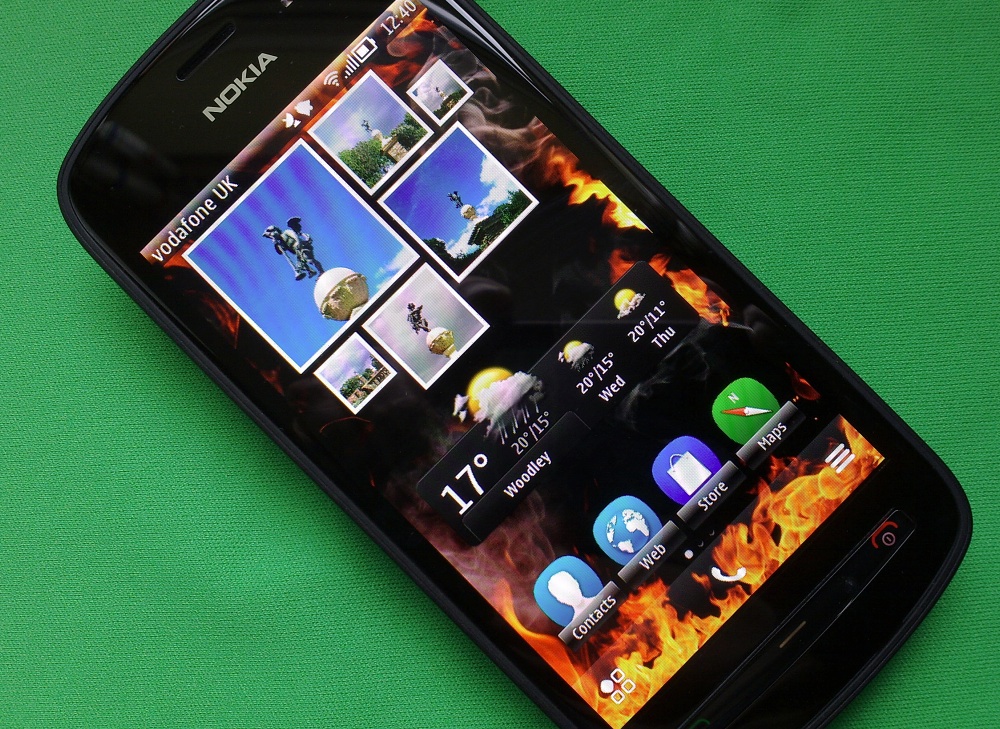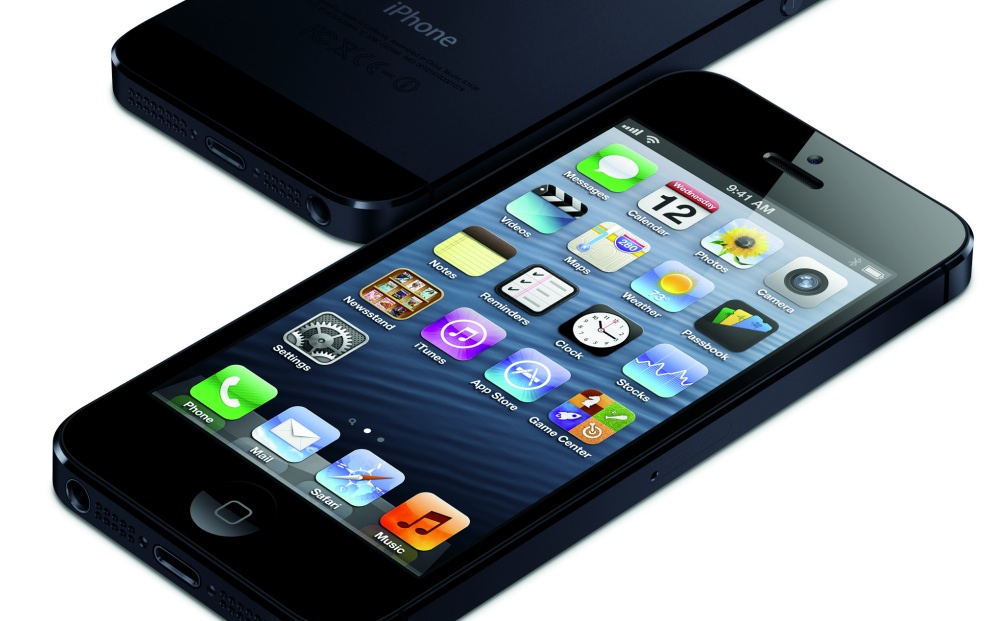
The physical
Lets back up that claim about look and dimensions first. Both the Nokia 808 PureView and Apple iPhone 5 have a plan form factor of roughly 124mm by 60mm and both have a 16:9 aspect ratio screen. OK, the 808 is heavier because there's more hardware inside and greater use of metal, plus there's the deliberately grippy matt polycarbonate finish of the 808 versus the deliberately silky smooth aluminium and glass of the iPhone, but the overall size in the hand and (arguably) overall use cases are definitely comparable.
Pick up a Samsung Galaxy Nexus or Galaxy S III, a HTC One X or similar and there's a definite feel of having to hold, manage and pocket a miniature tablet - the ratio of plan form factor to device thickness definitely crosses a boundary. My self-imposed rule of thumb is 'Could I walk around all day long with this in my hand and not be worried I was going to drop it?'. I've done the test and walked the walk over the summer, and 4", 16:9-screened phones like the 808 are perfectly secure, with my fingers closing around the other side of the device easily and safely. They can't do this for my Galaxy Nexus and as a result it has to live in a pocket or case for almost every second I'm not using it.
So strike one for the Nokia 808 and Apple iPhone 5 here - I've maintained for ages that 4" is about the sweet spot for a phone and both devices hit the mark with almost identical plan dimensions.

The software
I'd be doing the iPhone an injustice if I didn't lead off with the 'e' word: ecosystem. Much is made of the community of applications and services around each mobile platform and the iPhone leads ther way here. Anything you can ever think of using an iPhone for - someone's written 'an app for that', and it probably works better than you ever dreamed. Never mind that Nokia started the whole 'app store on a device' thing with its 'Download!' service back in 2005, it was horrifically under-resourced and as a result Apple stole the show. If applications are your thing then the iPhone wins here hands-down.
However, if your needs are for just the 'core' apps then I maintain Symbian, even lagging a lap or two behind in terms of ecosystem, can be very workable. The popular Gravity app, for example, handles all aspects of Twitter, Facebook, Google Reader and YouTube (and more) in one seamless, integrated interface that knocks spots off any solution on any other platform. Notekeeper for Evernote, Podcatcher for podcasts, Joikuspot Premium for tethering, Skype, and so on, when added to the now mature Email and (slightly limited, to one account) Mail for Exchange implementation, make for an awful lot you can do with the Nokia 808 if you don't need to step beyond these boundaries. I'd also mention one of Nokia's crown jewels - the built-in Maps system, complete with worldwide offline sat-nav, something which is unmatched on iOS unless you 'do a Symbian' and start buying up expensive commercial add-ons.
Overall, though, the iPhone 5 - of course - wins out in terms of software, and fairly easily.
Hardware functions and flexibility
This is where the Nokia 808 PureView edges it for me. Never mind that it's been hammered on the software side and that I've had to spend £20 or so on third party software just to bring the 808 up to parity on even a basic level to the iPhone, what attracts me about the Nokia 808 is its hardware prowess and flexibility.
In fact, this what has always attracted me about most Symbian hardware over the years - and usually Nokia-made in particular. It's the eve of the iPhone 5 sales across the world as I write this, so only a handful of people have had any serious hands-on time with it, but because it's so similar to the existing iPhone 4S I can confidently qualify the areas in which I'd class the Nokia 808 as having a distinct advantage:
- Removeable battery. Yes, this is turning into something of a crusade for me, but it's a massive issue. Batteries aren't magic, they're tubs of complicated chemistry and even the best Li-Ion cells only last for about 500 charges/cycles. The typical phone contract in 2012 is two years, after which the device will have been partially or completely discharged and charged around 600 times - possibly more. Yes, the battery in a 'sealed' device like the iPhone will still work after two years, but it'll be down to around half capacity.
And that annoys me, for any device. I want, repeat want to be able to pick up a two year old device, put a brand new battery in it and sell it on or give it to a relative with full charging power restored. With a two year old iPhone, you've got to take it to the Apple Store and suffer a £100 or so 'hit'.
Plus, of course, there's the benefit of having two batteries, perhaps, for slotting in a spare near the end of a day of heavy use. Yes, it sounds a little over the top, but this has saved my bacon more than once.
- Camera and camcorder. Don't get me wrong, the Apple iPhone 4S/5 has an excellent camera. Within the constraints of the tiny 1/3.2" sensor, Apple has worked miracles and in good light conditions photos and videos from the iPhone 5 will be outstanding. But I have to return to another of my regular rants - in the real world conditions will often be less than ideal: indoor office shots, parties and events, living rooms, down the pub etc. Under such conditions, the Nokia N8 and (here) the 808 PureView reign supreme - and I mean supreme, with huge sensor (hence the aforementioned bulge!) and a real flash, not some jumped up LED torch. It's a testament to Xenon flash that I could take my five year old Nokia N82 to an evening event and it would blow away every iPhone, every Android device, in terms of taking crisp, blur-free snaps.
The 808's camera then plays its ace in the hole, the PureView system, meaning that photos end up with almost zero digital noise. Plus you've got the option of zooming in on a subject from further away, losslessly, meaning that you can take less intrusive, more candid phtoos and videos - all from your always-with-you phone.
And then the 808 plays its second ace in the hole (if that's not a contradiction!) by recording the audio for its 1080p videos at 'better than CD' quality, in stereo, and even at full rock concert volume levels. I tell you, it takes capturing the moment to a whole new level - any subject, any light conditions, any volume levels. For the moment, that sort of capability is utterly unique to the Nokia 808 PureView.
- Data Flexibility. Over the years, I've been able to accomplish so much on Psions, Nokia Communicators and now Symbian smartphones like the 808 because of their flexibility. A file system, with multiple disks, that's fully accessible. Expansion if need be, via microSD, with the possibility of swapping files with others via card as well. Bluetooth object transfers in and out, wirelessly. No problem. Applications which open files from any source. Viewers or editors for just about everything, whatever format, whatever codec, all handled natively with no external computer needed. A variety of different (standard) USB cable modes mean I can plug into almost any computing device and achieve whatever I want. No restrictions, no closed file system, no limitations.
- Multitasking flexibility. Tech pundits like me have been round the loop on this one so many times since the iPhone was first launched. Yes, for the average man in the street, the Apple approach of severely limiting what third party applications can do 'in the background' has power benefits and ensures things don't go badly wrong. But this is a personal article, I'm trying to explain things from my point of view, that of someone who knows what they want to do and doesn't want to be crippled by OS decisions at every point along the way.
For example, when I switch to my Twitter applicaton of choice (usually Gravity, but Tweetian is also good), I want to see what's new instantly, i.e. I want the application to have been updating itself quietly while I got on with my life, ready so that when I turn the screen on or tap on the application icon or widget, the new data is just 'there'. And the same applies to podcasts, another core example from my personal smartphone experience - when I wake up in the morning, or when I flick my phone on as I head off for a walk, I want to know that all the latest programmes for all my favourite podcasts are already downloaded and waiting. No plugging into a desktop computer, no waiting ten minutes while something downloads, my media should just be there, with (in my case) the Nokia 808 running Podcatcher checking for podcasts and downloading silently and quietly in the background, with the phone screen off and the device ostensibly unused. When I have something downloading or a big web page rendering, I reserve the right to switch away, do something else and come back later and expect to find everything ready and waiting. It's what multitasking is all about on Symbian.
iOS is getting better in this regard, with a (somewhat buggy) Podcasts application finally appearing this year, but overall there's a definite feel of 'not that much happens until I have the app in the foreground' in quite a few functions.
- Screen clarity. I have - quite literally - lost count of the number of times people have commented on the clarity of the display on my Nokia 808. I absolutely accept that the iPhone 5's resolution is higher and that you can see the pixels on nHD on a 4" screen if you look closely. But the combination of gorgeous AMOLED colours/blacks and the 'ClearBlack Display' polarisers mean that the 808 is fully useable outdoors in sunlight, whereas on the IPS-screened iPhone 4/4S/5 range, I always end up looking for some shade so I can read the screen better.
The choice
Did much of the above sound like a rant? Apologies. But I do get annoyed that the tech world falls over itself to praise the Apple iPhone at every single turn and ridicules Symbian devices like the Nokia 808, even when the above bullet list of advantages is fairly indisputable.
I'm not saying that the Nokia 808 PureView is a much better phone than the Apple iPhone 5. The latter clearly wins in terms of software and ecosystem, the Nokia clearly wins (to me) in terms of functions and flexibility, while both are superbly built and designed, both have great component quality at every point. It's a tough choice overall, but.... I'd, personally, still take the 808, for all the empassioned benefits listed above.
What about you? Oh, and do please share this article online, it might open a few iOS lover's eyes to a competitor that doesn't hail from Mountain View.
PS. Just for comparison, current best new prices are £439 inc VAT for the Nokia 808 PureView and £529 for the cheapest Apple iPhone 5.
PPS. Notice I didn't even mention the 808's FM transmitter, pentaband radios etc..... 8-)
